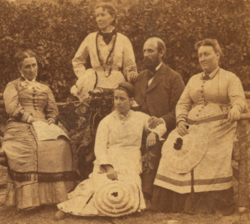
Back تعدد الزوجات في المورمونية Arabic Polygamie v mormonismu Czech Polygamie (Mormonen) German Mormonismo y poligamia Spanish مورمنیسم و چندهمسری Persian Moniavioisuus (mormonismi) Finnish Mariage plural French Mormonismo e a poligamia Portuguese Многожёнство мормонов Russian Ubumomoni nesithembu Zulu
| Mormonism and polygamy |
|---|
 |
|
|
Polygamy (called plural marriage by Latter-day Saints in the 19th century or the Principle by modern fundamentalist practitioners of polygamy) was practiced by leaders of the Church of Jesus Christ of Latter-day Saints (LDS Church) for more than half of the 19th century, and practiced publicly from 1852 to 1890 by between 20 and 30 percent of Latter-day Saint families.
Polygamy among Latter-day Saints has been controversial, both in Western society and within the LDS Church itself. Many U.S. politicians were strongly opposed to the practice; the Republican platform even referred to polygamy and slavery as "the twin relics of barbarism." "[1][2]: 438 " Joseph Smith, founder of the Latter-day Saint movement, first introduced polygamy privately in the 1830s. Later, in 1852, Orson Pratt,[3], a member of the Quorum of the Twelve Apostles, publicly announced and defended the practice at the request of then-church president Brigham Young.
Throughout the 19th and early 20th centuries, the LDS Church and the United States remained at odds over the issue. The church defended polygamy as a matter of religious freedom, while the federal government, in line with prevailing public opinion, sought to eradicate it. Polygamy likely played a role in the Utah War of 1857–1858, as Republican critics portrayed Democratic President James Buchanan as weak in opposing both polygamy and slavery. In 1862, the U.S. Congress passed the Morrill Anti-Bigamy Act, prohibiting polygamous marriage in the territories. Despite the law, many Latter-day Saints continued to practice polygamy, believing it was protected by the First Amendment. However, in 1879, the U.S. Supreme Court upheld the Morrill Act’s constitutionality in Reynolds v. United States,[4] asserting that while laws could not interfere with religious belief, they could regulate religious practices.[3]
In 1890, when it became clear that Utah would not be admitted to the Union while polygamy was still practiced, church president Wilford Woodruff issued the 1890 Manifesto,[5] officially terminating the practice of polygamy within the LDS Church.[6] Although this manifesto did not dissolve existing polygamous marriages, relations with the United States markedly improved after 1890, such that Utah was admitted as a U.S. state in 1896. After the manifesto, some church members continued to enter into polygamous marriages, but these eventually stopped in 1904 when church president Joseph F. Smith disavowed polygamy before Congress and issued a "Second Manifesto", calling for all polygamous marriages in the church to cease, and established excommunication as the consequence for those who disobeyed. Several small "fundamentalist" groups, seeking to continue the practice, split from the LDS Church, including the Apostolic United Brethren (AUB) and the Fundamentalist Church of Jesus Christ of Latter-Day Saints (FLDS Church). Meanwhile, the LDS Church continues its policy of excommunicating members found practicing polygamy, and today actively seeks to distance itself from fundamentalist groups that continue the practice.[7] On its website, the church states that "the standard doctrine of the church is monogamy" and that polygamy was a temporary exception to the rule.[8][9]
Adherents of various churches and groups from the larger Latter Day Saint movement continue to practice polygamy.[10]
- ^ US History.org website
- ^ Cite error: The named reference
:6was invoked but never defined (see the help page). - ^ a b Embry, Jessie L. (1994), "Polygamy", in Powell, Allan Kent (ed.), Utah History Encyclopedia, Salt Lake City, Utah: University of Utah Press, ISBN 0874804256, OCLC 30473917, archived from the original on April 17, 2017, retrieved October 30, 2013
- ^ Reynolds v. United States “The History of The Supreme Court”
- ^ Lyman, Edward Leo (1994), "Manifesto (Plural Marriage)", Utah History Encyclopedia, University of Utah Press, ISBN 9780874804256, archived from the original on July 31, 2024, retrieved August 19, 2024
- ^ Official Declaration 1
- ^ The LDS Church encourages journalists not to use the word "Mormon" in reference to organizations or people that practice polygamy "Style Guide – LDS Newsroom". April 9, 2010. Retrieved April 15, 2014.; the church repudiates polygamist groups and excommunicates their members if discovered Bushman (2008, p. 91); "Mormons seek distance from polygamous sects". NBC News. 2008.
- ^ LDS Church, Polygamy: Latter-day Saints and the Practice of Plural Marriage, LDS Newsroom
- ^ Jacob 2:27–30
- ^ Brady McCombs (November 12, 2019). "Mexico killing highlights confusion over Mormon groups". KUTV. Associated Press.